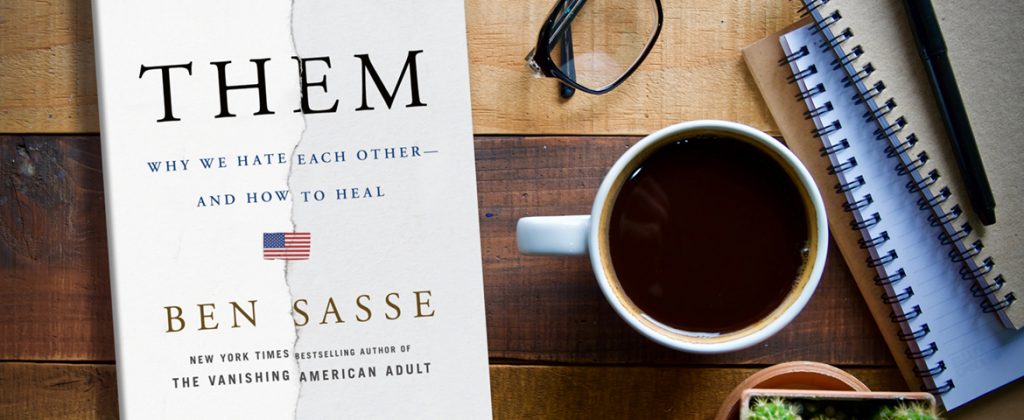Blog Post
Why do we hate each other so much?
By Jonathon Van Maren
On the heels of his 2017 book The Vanishing American Adult: Our Coming-of-Age Crisis and How to Rebuild a Culture of Self-Reliance comes Nebraska Senator Ben Sasse’s second book, Them: Why We Hate Each Other—and How To Heal. I genuinely have no idea how a busy senator has the time to research and write books this thoughtful and comprehensive, but Sasse has once again produced a volume that stares America’s current crisis right in the face—and attempts to end on an optimistic and productive note (although, just as with his previous book, his analysis is a tad too devastating to make his uplifting closing rhetoric particularly convincing.) In his latest offering, Sasse tries to explain why America seems to be coming apart at the seams.
One of the problems with today’s America is that despite our constant digital connectedness, we no longer have the community cohesion that we once enjoyed. We are now a more rootless people and, more shockingly, loneliness is markedly on the rise. In fact, says Sasse, saying that someone “died of a broken heart” is not only a literary device—rejection or loss can flood the body with stress hormones, mimicking the effect of a heart attack. Emotional stress also causes us to age faster, while positive social relationships are second only to genetics in predicting health and longevity. Those relationships are in shorter and shorter supply these days.
Loneliness, says Sasse, is one of the primary reasons that life expectancy is slumping in the United States, especially among men. A third of those over the age of forty-five now struggle with loneliness, and even the sharp rise in depression can often be attributed directly to this (people are more willing to say they are depressed than lonely). Men tend not to make friends as well when they are in their thirties, and thus social disruption tends to contribute to loneliness, as well. As a result drugs—including opioids—are often being utilized to replace the feelings people get from real friendships, relationships, or even sex. Every day in America, 116 people die from opioid overdoses.
There are countless factors to consider here. On the religious front, people stopped attending church altogether or began attending mega-churches that lack community. TV and broken families resulted in a decline in people eating together, families vacationing together, and visiting each other. Over the past three decades, the number of friends the average American says they can discuss intimate things with has gone down to less than two, and a quarter of Americans say they have nobody they can discuss important things with at all. In 1964, 77% of people thought most of their fellow citizens could be trusted. That number now sits around 30%–and drops even further when it comes to trust in government.
According to most scholars, there are three primary factors to success in life: Finish high school, get a job (any job, because working leads to more jobs), and get married before having children. Parents and family, it turns out, are the single greatest predictor of success–period. Sasse proposes four main drivers of human happiness, framed as questions:
- Do you have a family you love and who loves you?
- Do you have friends you trust and confide in?
- Do you have work that matters—a calling that benefits your neighbors?
- Do you have a worldview that can make sense of suffering and death?
Not so long ago, people took for granted that even if you were poor, you would still be able to answer in the affirmative to all (or nearly all) of these questions. For thousands of years, people ate, worked, worshipped, and communed together in tribes—and then the Industrial Revolution blew the village to smithereens, and our atomization has been progressing apace ever since.
And Sasse believes things could get much worse. Vehicle driving of some sort, for example, is the number one job in 37 of 50 states (including cabbies, bus drivers, and truckers, among others.) If the self-driving vehicle becomes a reality—and it very likely will—two thirds of these jobs could evaporate in the next decade. This, incidentally, is why Tucker Carlson has actually advocated that the government spike or slow this research, demanding to know why would we fund such a catastrophic upheaval in the lives of so many working men, upheaval that will in all likelihood lead to family breakdown. Many social psychologists are highlighting the fact that this shift will bring with it a staggering level of social disruption.
But Sasse believes that the predictors of catastrophe may be overstating things somewhat. After all, around World War II fifty percent of the population were farmers and ranchers, and today only 2% are. Despite this, agricultural output skyrocketed (although the more traditionally-minded might have a thing or two to say about factory farming.) Farm life largely vanished, but production did not. Although automation will continue to result in cataclysmic changes, Sasse says that the level of automation is somewhat exaggerated. The essential thing about work, he writes, is that it gives you a place in the world, it makes you feel needed, and it gives you a sense of worth. The specific kind of work is not as important, and he is convinced that replacements for the jobs that automation takes will come.
Aside from loneliness and economic upheaval, Sasse pinpoints the cultural toxin that he believes is torqueing much of America’s divisions: The media complex he refers to as “polititainment.” He recaps the already well-proven thesis that TV has made everyone dumber, and notes that politics has become entertainment for many people—a form of pro-wresting where people scrap for the camera before leaving for a few beers, a fake performance that satisfies the audience without actually accomplishing anything. People are using politics as a stand-in for the religious beliefs they abandoned, which has contributed to the fury and fervor with which people engage as well as the cults of personality that increasingly crop up around politicians.
The frenzied news cycle hasn’t helped. It is now possible to view world events unfolding in real time, and because of the Internet, everything seems much closer and more relevant than it ever did before. The business models of media organizations are also oriented towards consumers, with confirmation bias occurring as an inevitable result. Most people do not even fully realize that the news they consume generally confirms what they already believe rather than challenging it, and despite this fact 66% of Americans still believe that the media is doing a terrible job (while a majority of journalists, predictably, believe things are going hunky-dory.) Journalists inhabit bubbles even more airtight than those they serve—when Hugh Hewitt asked one New York Times editor on a TV panel if she knew any pro-lifers, the sputtering and stuttering response indicated that she most certainly did not.
Sasse says that not all journalist bias is intentional—because most journalists are not from certain areas of America, he writes, they simply don’t understand how to cover those areas. They are largely secular, and so they don’t know how to cover religion or religious liberty (many journalists are so disconnected from the world of believers that they do not even understand it as a valid concept.) And then, of course, there’s the infamous story of abortionist Kermit Gosnell, which featured horrifying stories of women being tied down and their babies aborted against their will, fetal beheadings, and more—but the media either ignored or minimized the story because it made the abortion industry look awful.
The contempt felt by conservative-minded people because of this overt bias has created a business boom for FOX News, which makes cash by the bucket using what Sasse calls “the polarization model.” He uses Sean Hannity, who earns forty million a year, as Exhibit A. Hannity’s shtick, says Sasse, boils down to a simple pattern: Liberals are evil, you’re a victim, and you should be furious. And because there’s always somebody doing something stupid, it isn’t hard to do what Sasse calls “nut-picking”—select an example of particularly egregious left-wing behavior, highlight it as a microcosm of the whole, and whip the audience up into a frenzy. People get intoxicated by anger, and come back for more. The media hosts get rich making people blow a gasket, and the more effectively they can demonize the other side, the better. Views—and clicks—are cash.
Deep down we all know this is a poisonous cycle. Everyone is trapped on a treadmill where they keep drinking it in and the media keeps pumping it out because it makes them rich and everything gets worse as a result. Sasse even cited conversations with media experts working with big cable channels that admitted that sometimes, making those who already hate your point of view hate you even more is a great way to drive clicks—and again, clicks are cash. On the right side of the spectrum, Sasse says that three of the top twelve conservative media hosts in the country told him that they only had to hit him so hard when he publicly opposed Trump because that’s what their audiences wanted—but that Sasse shouldn’t be offended, because it is all just a game. In short, many of the blowhards on TV—both Left and Right—are knowingly saying things that they do not believe simply to stoke anger and division for money. Destroying the nation’s social fabric pays well.
The other thing that is important to note is that there is now no “public square” per se—everybody tailor-makes their own public square that works for them, with social media algorithms helping things along. We can now be alone together, never having to share the same country, dwelling in a sea of bubbles. For example, Sean Hannity’s show is the most popular one on TV and only about 1% of the country watches it, with his second-place competitor Rachel Maddow getting well below that. The same is true for entertainment: TV shows like I Love Lucy used to get three quarters of the American population, but even the pornographic Game of Thrones is lucky to get within striking distance of 4% (and that’s good news for a change.) TV has placed politics and power at the center of American life, and it has become a reality show drama that everyone has joined—FOX, MSNBC, and CNN alike. Each network wants dramas of good and evil, and thus someone has to be evil. Demonization is part of the formula.
Sasse’s analysis of the public is perhaps even more devastating than he realizes. He’s not sure who is worse—the rage-addicted Americans, or the apathetic millions hooked on porn and Netflix. The most obvious culprit, he says, is the failure of one generation to pass their values on to the next, caught up in the consumer marathon and new technology and greed. To begin to address this limitless brokenness, he has a few proposals—although after reading a couple of hundred pages on the challenges we face, they seem as underwhelming as they do necessary. We should be setting tech limits, he notes, before tech takes over and destroys our lives. Children in particular should get virtually no screen-time—he highlights the fact that the very Silicon Valley experts who create this technology refuse to give it to their children.
Interestingly, one of the primary evidences of our collective addiction is the fact that people get so defensive when someone suggests that we limit our tech use. People now insist that they “can’t” get along without it, despite the fact that every previous generation did just that. Social media platforms are actually programmed to addict people, and a full 40% of Americans between the ages of 18 to 29 are now online constantly as long as they are awake. Technology is actually replacing people, porn is replacing sex, social media is replacing community, real life is being replaced by Second Life, and phones are even destroying sleep, which is essential to health and basic function. Social media is quite literally robbing us at our own request, as it takes us out of the here and now—the only life that we have. It makes us dissatisfied with what is ours, and it makes us miss what we should love. Smartphones reduce our freedom, as we feel compelled to be elsewhere.
If you boil Sasse’s solution down, it really is a simple one: We must return to the first things. Family, community, each other—we must realize once again that in a world of endless distraction, only turning our attention to those we should love (and must love better) can bring us any happiness. The source of joy is right in front of us, if only we put down our smartphones and shut our laptops and open our eyes. America’s challenges, Sasse says, are monumental—but an America that returns to the values of the Founding can yet rise to the task. And to that, of course, we can merely nod vigorously and pray that he is right.
_________________________________________________________
For anyone interested, my book on The Culture War, which analyzes the journey our culture has taken from the way it was to the way it is and examines the Sexual Revolution, hook-up culture, the rise of the porn plague, abortion, commodity culture, euthanasia, and the gay rights movement, is available for sale here.









“The contempt felt by conservative-minded people because of this overt [leftist media] bias has created a business boom for FOX News, which makes cash by the bucket using what Sasse calls ‘the polarization model.’ ”
Hmm, so let me get this straight: the mainstream media goes left, conservatives react to it through the venue of Fox News – and that polarization is Fox’s fault . . . ?
That’s like blaming World War II on the Allies, rather than on Germany and Japan. In a media overwhelmingly drenched with cultural and sometimes even political Marxism, Fox News is a breath of fresh air.